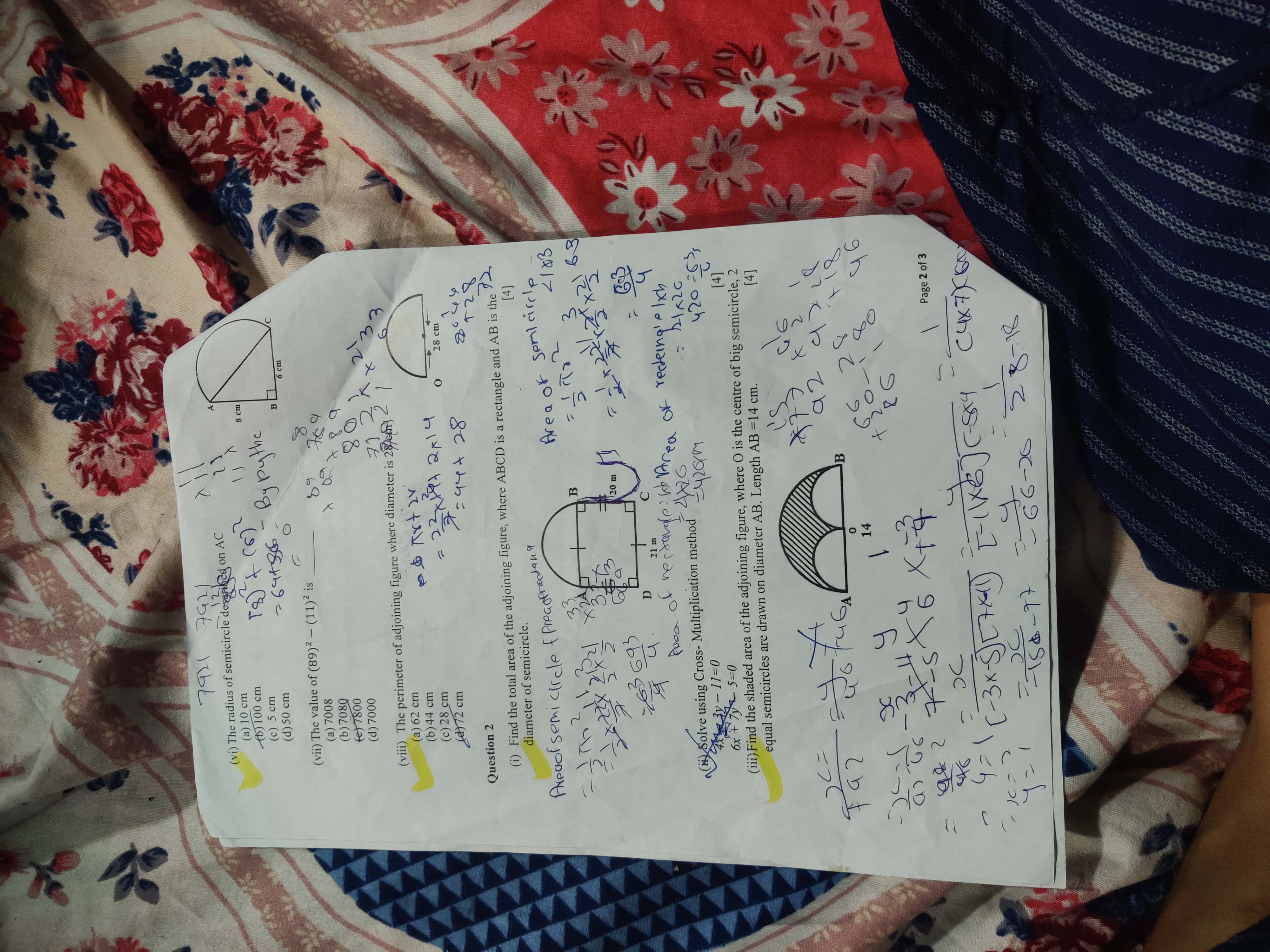Solve the geometry and algebra problems in the attached image.

Understand the Problem
The question is asking us to solve several math problems related to geometry and algebra. These include finding the radius of a semicircle, calculating the value of an expression, finding the perimeter and area of combined shapes, solving equations using cross-multiplication, and determining the shaded area in a geometric figure.
Answer
(vi) 5 cm (vii) 7800 (viii) 72 cm Question 2 (i) $593.25 \, m^2$ (ii) $x = 6.2$, $y = -4.6$ (iii) $38.5 \, cm^2$
Answer for screen readers
(vi) (c) 5 cm (vii) (c) 7800 (viii) (d) 72 cm
Question 2 (i) $593.25 , m^2$ (ii) $x = 6.2$, $y = -4.6$ (iii) $38.5 , cm^2$
Steps to Solve
- (vi) Find the length of AC using Pythagoras theorem
In the right-angled triangle ABC, we have AB = 8 cm and BC = 6 cm. Using the Pythagorean theorem, $AC^2 = AB^2 + BC^2$ $AC^2 = 8^2 + 6^2 = 64 + 36 = 100$ Therefore, $AC = \sqrt{100} = 10$ cm
- (vi) Find the radius of the semicircle
Since AC is the diameter of the semicircle, the radius is half of the diameter. Radius $= \frac{AC}{2} = \frac{10}{2} = 5$ cm
- (vii) Simplify the expression $(89)^2 - (11)^2$
Using the difference of squares formula, $a^2 - b^2 = (a + b)(a - b)$ $(89)^2 - (11)^2 = (89 + 11)(89 - 11) = (100)(78) = 7800$
- (viii) Calculate the perimeter of the figure
The perimeter consists of the semicircle's arc length and the diameter. The diameter is given as 28 cm, so the radius is $\frac{28}{2} = 14$ cm. The arc length of a semicircle is $\pi r = \pi \times 14 = 14\pi$. Using $\pi = \frac{22}{7}$, the arc length $= 14 \times \frac{22}{7} = 2 \times 22 = 44$ cm.
The perimeter is the arc length plus the diameter: $44 + 28 = 72$ cm.
- (i) Find the total area of the figure
The figure consists of a rectangle and a semicircle. Let's assume the sides of the rectangle are 21m and 20m. The area of the rectangle is $21 \times 20 = 420 , m^2$. The diameter of the semicircle is 21m, so the radius is $\frac{21}{2}$m. Area of semicircle = $\frac{1}{2} \pi r^2 = \frac{1}{2} \times \frac{22}{7} \times (\frac{21}{2})^2 = \frac{1}{2} \times \frac{22}{7} \times \frac{441}{4} = \frac{11}{1} \times \frac{63}{4} = \frac{693}{4} = 173.25 , m^2$ Total area $= 420 + 173.25 = 593.25 , m^2$
- (ii) Solve the equations using cross-multiplication
Given equations: $4x + 3y - 11 = 0$ $6x + 7y - 5 = 0$
Using cross-multiplication method: $\frac{x}{(3 \times -5) - (7 \times -11)} = \frac{y}{(-11 \times 6) - (-5 \times 4)} = \frac{1}{(4 \times 7) - (6 \times 3)}$ $\frac{x}{-15 + 77} = \frac{y}{-66 + 20} = \frac{1}{28 - 18}$ $\frac{x}{62} = \frac{y}{-46} = \frac{1}{10}$ $x = \frac{62}{10} = 6.2$ $y = \frac{-46}{10} = -4.6$
- (iii) Find the shaded area
The shaded area is equal to the area of the big semicircle minus the area of the two smaller semicircles. The radius of the big semicircle is $\frac{14}{2} = 7$ cm. Area of big semicircle $= \frac{1}{2} \pi (7)^2 = \frac{1}{2} \times \frac{22}{7} \times 49 = 11 \times 7 = 77 , cm^2$
The radius of each smaller semicircle is $\frac{14}{2 \times 2} = \frac{7}{2} = 3.5$ cm. The area of two such semicircles is equal to area of 1 full circle. $= \pi r^2 = \frac{22}{7} \times (3.5)^2 cm^2 = \frac{22}{7} \times 12.25 = 22 \times 1.75 = 38.5 , cm^2 $
Shaded area $= 77 - 38.5 = 38.5 , cm^2$
(vi) (c) 5 cm (vii) (c) 7800 (viii) (d) 72 cm
Question 2 (i) $593.25 , m^2$ (ii) $x = 6.2$, $y = -4.6$ (iii) $38.5 , cm^2$
More Information
The Pythagorean theorem is crucial for solving right-angled triangle problems. The difference of squares factorization makes calculation easier. Perimeter involves adding up all the lengths of the outer boundary. Area calculations for rectangles and circles are fundamental geometric concepts. Cross multiplication is a useful method for solving simultaneous equations.
Tips
- For (vi), a common mistake is to select 10 cm as the answer (the length of AC), forgetting that the question asks for the radius of the semicircle.
- For (vii), not applying the difference of squares formula and directly calculating $89^2$ and $11^2$ might lead to arithmetic errors.
- For (viii), a common mistake is to only calculate the arc length($\frac{2\pi r}{2}$) and forgetting to add the diameter to get to the perimeter of the shape.
- In question 2(i), forgetting to take half the base to calculate the radius when finding the area of the semicircle.
- In question 2(ii), being careless with the signs during cross-multiplication.
- In question 2(iii), forgetting that two semi-circles make one full circle
AI-generated content may contain errors. Please verify critical information